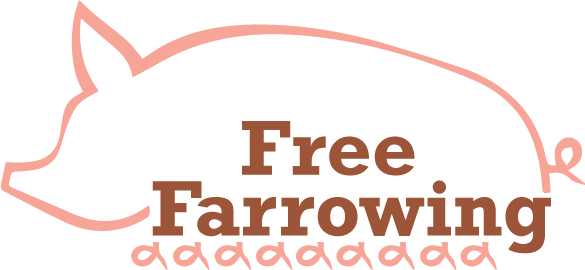Design features in a farrowing pen can have a significant impact on how well it operates. They can affect maternal behaviour, animal health and welfare as well as operator efficiency and safety.
Our research and experience has shown that the details of a specific design feature are crucial to its success within a farrowing system.
Piglet protection

Conventional farrowing crates rely on the rails of the farrowing crate to help reduce the incidence of piglets being crushed. Research has demonstrated that sows prefer to lie against a sloped or vertical wall rather than use a farrowing rail.
What are the biggest risks for piglets
- Crushing as the sow descends
- Rolling from lateral lying to ventral lying
- Trapping between the sow and the pen walls
- Trapping in the creep
- Poor teat access
- Chilling
What are the best piglet protection features
To learn more about physical pen features that keep piglets safe in free farrowing systems, download a copy of our piglet protection recommendations pdf.
Other Piglet Protection Methods
Improve Maternal Behaviour
In addition to the “nuts and bolts” approach of adding pen furniture, improving sow behaviour will also keep piglets safe. To learn more about this, please visit our research page.
Provide Deep-bedded Substrate
Deep bedding can protect piglets – this is very important in multisuckle and outdoor systems. Management of deep straw systems should be optimised to make sure the straw protects the piglets rather than hampers their progress to the udder.
Optimise Creep Design
To learn more about optimising creeps for piglets, view our piglet creeps section below.
Pen partitions

A wall is a wall right? Wrong! There are a number of things to consider when creating the shell of the pen.
Wall height
- Sows need to feel enclosed and have minimal disturbance during farrowing
- Staff need to be able to see pigs
- Staff need to be safe – sows should not be able to jump between pens
Solid or Barred?
- Both – solid in the lying/nest areas, barred and open in the dunging area

Access points
- The more access points the easier for staff
- But the more access points the more mechanics in the build, so potentially more expensive
Materials
- Supportive/Solid (sow will “test” the system – weaknesses will be found + weaknesses may make sows lose confidence and not use support)
- Easy to clean
- No horizontal bars – sows can climb if they want to!
Learn more about all aspects of pen partitions by viewing our pen partitions recommendations pdf.
Piglet creep designs

A creep is a section of the farrowing pen which is inaccessible to the sow.
Why have a creep?
- To provide supplementary heat
- To provide a protected area inaccessible to the sow
- To provide an area where piglets can be easily inspected by staff
- To provide supplementary feed
What are the optimal creep designs?
Although piglets like to stay near the udder for the first 24h post-farrowing (to gain valuable colostrum and establish a teat) some creep designs are more successful than others in attracting the piglets into them.

To find out more information on creep design (i.e. corner or front?), dimensions and recommendations for creep fronts, view our creep recommendations pdf.
Flooring advice

There are a number of things to consider when installing any flooring for livestock. In the farrowing house the sow’s needs and the piglets’ needs must be addressed. In a farrowing and lactation system where the sow is loose and substrate is likely to be provided there are additional considerations.
Key Considerations
Floor should:
- Adhere to regulations for slat widths and voids – refer to our Know the Rules for further information
- Have strong support structures under any slats – sows will be moving about more than in conventional systems
- Be non-slip
- Have good drainage – consider how to cope with fluid (i.e. provide slope, provide additional substrate)
- Be non-abrasive
- Be hygienic – floors should be easy to clean
- Cope with provision of nesting material – consider your slurry system options
For more information to help you make the right flooring decisions, download our flooring recommendations pdf.
Feeders and drinkers

Correct placement and angle of drinkers for both sows and piglets are obvious but important design considerations for any housing system. Feeder design and placement can influence dunging behaviour and can affect hygiene levels.
Key considerations
Drinkers should be:
- The correct height, angle and flow rate to allow maximum water intake
- Placed over a slatted or drained area
Feeders should be:
- Placed over a slatted or drained area if wet-feed
- Able to be viewed by staff to check feed-intake
- Smooth edged for easy cleaning
- Placed in a location that promotes good hygiene (feeding and dunging behaviour are linked, click on our download below to learn more)
To learn more about optimum drinker and feeder design and optimum placement in a free farrowing system, download our drinker and feeder recommendations pdf.

